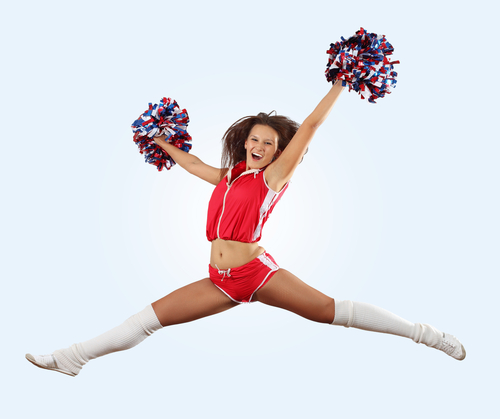Cheer leading has often been seen as one of the bonuses of watching other forms of organized sport, only recently receiving notoriety as a sport and hobby onto itself. Cheer leading consists of a team of dancers and gymnasts that create and practice short uplifting dances that usually last one to three minutes long, usually to rev up a team or celebrate scores. Today it is practiced by at least 4.5 million people in at least 79 countries who take the sport seriously and see it as more than a simple pass time or bonus of other sports. How has cheer leading evolved throughout the years?

The Beginning of Cheer Leading
Although cheer leading is now almost solely associated with fit young women excitedly celebrating men’s athletic prowess, it began in 1884 as an all-male sport at one of America’s most prestigious universities, Princeton. In 1903, the first cheer leading fraternity was formed to cultivate even more support for Princeton’s sports’ teams. Cheer leading began spreading around the country at this time, building up to the establishment of The National Cheerleaders Association in 1949 to regularize and promote the sport. During this time, more and more women began participating, probably thanks to the greater opportunities open to them in general as a result of so many men going away for war during WWII. These changes were accompanied by the design of the first synchronized outfits for the sport. Workshops around the country started popping up, spreading the methods and popularity of the sport.
Modern Cheer leading
Modern cheer leading took its form in the 1970s, whereby it no longer consisted of a simple grouping of people ready to loudly and flamboyantly cheer on a sports team, but became a sport that consisted of teams of athletes that trained long and hard to create intricate and complicated routines – like athletes in any other type of sport. This was helped along by the passage of Title IX legislation that required women to be allowed to participate in all sports and requiring funding for women’s sports teams. This funneled more funds and more interest into cheer leading, leading to the development of the sport into a truly athletic undertaking. The first official stunt, or designed move or performance that challenges a team’s skills and dexterity and usually in the shape of some form of pyramid, was officially designated by the National Cheerleaders Association in 1976. By 1979, the extremely popular stunt known as the basket toss was taught around the country by the Universal Cheerleaders Association.
As the sport gained popularity, people who were not affiliated with a school or sports team wanted to join troops and learn to dance. Because prior to this time all cheer leading squads were somehow attached to sports teams, new leagues had to be created to accommodate these newcomers. All Star cheer leading teams began to be formed, adhering to different regulations than school teams and arguably allowing for a more creative and interesting production. Today, All Star teams are some of the most popular cheer leading squads around, competing in cheering competitions in front of audiences of thousands of people. In 2004, the US hosted the first world competition for non-affiliated All Star cheer leading troops, solidifying its place as a legitimate and challenging sport.
Cheer Leading as a Life Choice
Today, students at all levels can opt to join a cheer leading squad and learn complicated stunts, synchronized dances, and impressive gymnastic moves. Joining a team for younger children can keep them active while conditioning their bodies for a healthy lifestyle and teaching them how to work in teams in support of another group. In high school, participating in an award-winning team can lead to university admission and even scholarships. Interestingly, after university where cheering teams are roughly equally composed of men and women, moving into professional cheering seems to be solely the option of women who make up 97% of professional cheerleaders. If a woman is serious about cheering throughout university, she has a small chance of working professionally for a major sport’s team, earning around $22,000 a year.
Cheer leading has become a global sport in little over a century’s time, it is not just some girls wearing their nicest NFL apparel. It helps people around the world enjoy physical activity while admiring and supporting their teams. It can even earn some people a bit of money, in the form of scholarships or eventual employment. Cheer leading is now an essential part of major sports worldwide, bringing together millions of people with every dance.
